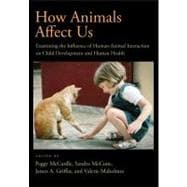
Note: Supplemental materials are not guaranteed with Rental or Used book purchases.
Purchase Benefits
What is included with this book?
| Contributors | p. xi |
| Foreword | p. xiii |
| Acknowledgments | p. xv |
| Human-Animal Interaction Research: An Introduction to Issues and Topics | p. 3 |
| Methodology | p. 11 |
| Principles for Human-Animal Interaction Research | p. 13 |
| Establishing the Effectiveness of Animal-Assisted Therapies: Methodological Standards, Issues, and Strategies | p. 35 |
| Promises and Pitfalls of Hormone Research in Human-Animal Interaction | p. 53 |
| Human-Animal Interaction and Child Development | p. 83 |
| How Very Young Children Think About Animals | p. 85 |
| The Other Side of the Bond: Domestic Dogs' Human-Like Behaviors | p. 101 |
| Animal Abuse and Developmental Psychopathology | p. 117 |
| Human-Animal Interaction and Human Health | p. 137 |
| Childhood Obesity and Human-Animal Interaction | p. 139 |
| Health Correlates of Pet Ownership From National Surveys | p. 153 |
| Physiological Correlates of Health Benefits From Pets | p. 163 |
| Animal-Assisted Intervention in Health Care Contexts | p. 183 |
| Afterword: An Agenda for Future Research | p. 193 |
| Appendix: A Resource for Studying Human-Animal Interaction | p. 203 |
| Index | p. 215 |
| About the Editors | p. 227 |
| Table of Contents provided by Ingram. All Rights Reserved. |
The New copy of this book will include any supplemental materials advertised. Please check the title of the book to determine if it should include any access cards, study guides, lab manuals, CDs, etc.
The Used, Rental and eBook copies of this book are not guaranteed to include any supplemental materials. Typically, only the book itself is included. This is true even if the title states it includes any access cards, study guides, lab manuals, CDs, etc.